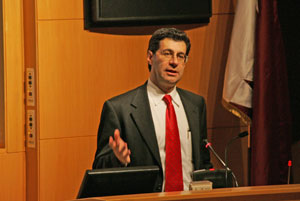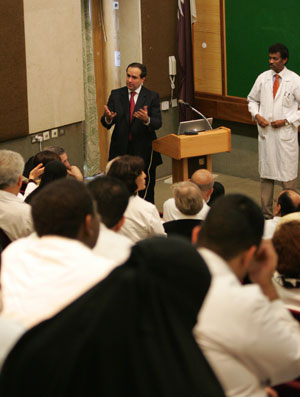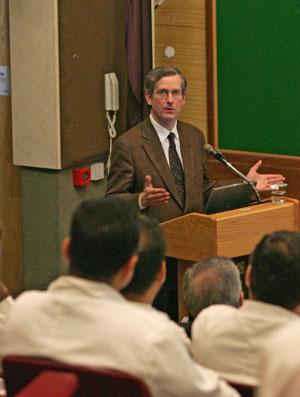Visits Prepare Way for Closer Cooperation with Partners

Dr. David P. Hajjar
Dean of the Weill Graduate School of Medical Sciences of Cornell University, David P. Hajjar, Ph.D. and senior members of faculty at Weill Cornell Medical College in New York (WCMC-NY) who also hold clinical appointments at NewYork–Presbyterian Hospital (NYPH) were in Doha early February to see for themselves progress made at WCMC–Q, and to hold several rounds of meetings with leaders at Qatar Foundation, and clinicians and the leadership at Hamad Medical Corporation (HMC.)
Among the visitors, Frank Chervenak, M.D., the Given Foundation Professor and chairman of obstetrics and gynecology at WCMC–NY, and obstetrician–in–chief at NYPH, was making a return visit to Doha after more than 3 years. For Fabrizio Michelassi, M.D., Lewis Atterbury Stimson Professor and chairman of surgery at WCMC–NY, and surgeon–in–chief at NYPH, this was his first opportunity to see the Medical College in Qatar, and to meet personnel at HMC.
While in Doha, Dr. Hajjar, who is the Frank H.T. Rhodes Distinguished Professor of Cardiovascular Biology and Genetics and professor of biochemistry and pathology at WCMC-NY, delivered lectures at both the Hamad Hospital and WCMC-Q.
A leading researcher in the field of vascular disease, and director of the Cornell Center of Vascular Biology, Dr. Hajjar was the first investigator to determine that infections and inflammatory agents, particularly viruses such as herpes, play a part in changes in the arterial wall.
In his lecture, Dr. Hajjar examined in detail how atherosclerosis, or hardening of the arteries, occurs. It can happen anywhere in the body, leading to strokes and heart disease, among other events. Atherosclerosis is a multi-factorial disease, in which raised levels of LDL or "bad" cholesterol may have a role, although Dr. Hajjar cautioned that 50% of deaths in the U.S. from cardiovascular disease occur in people with normal cholesterol levels.
While there are non-modifiable factors in the development of atherosclerosis (for example, genetics), obesity and type 2 diabetes are significant risk factors. Dr. Hajjar noted that little information about the relation between these conditions and cardiovascular disease has been gathered in the Middle East region, and this is a subject that the proposed research program at WCMC-Q will address.

Dr. Frank A. Chervenak
The focus of attention now among researchers is on transport of lipoproteins: their removal from cells by means of HDL or "good" cholesterol. This action may be enhanced by two new "transporter" molecules, he explained. In addition, new transcriptional factors (PPARs) may have a role to play both in lowering levels of LDL in cells and in regulating the inflammatory process.
Presenting Grand Rounds in the Women’s Hospital of HMC, Dr. Frank Chervenak argued that both the risk of future complications and ethical principles support the case for discouraging patients from choosing a Cesarean section, except in cases where it is medically indicated.
He noted that Cesarean section is the most commonly performed obstetric procedure, and that it is both appropriate when medically indicated and safe. However, he stressed that such major surgery may lead to adhesions (on which more research is needed) and - in women who have many subsequent such procedures - there is a risk of placenta accreta, a condition in which the placenta erodes into the wall of the uterus. Evidence published in the medical journal "The Lancet" in 2003 also showed a heightened risk of stillbirth during a subsequent pregnancy, he said.
Describing ethics as "mainstream" in obstetrics and gynecology, part of every resident's training and one of his core interests, Dr. Chervenak discussed a number of key principles. He explained that the concept of beneficence is "a much more comprehensive and important principle than ‘first do no harm’" and it requires a clinician to do what is best for the patient, based on the diagnosis and therapeutic options.
At the same time, "a patient has a perspective . . . based on her values and beliefs," and she has a right to choose. Where this choice is for a Cesarean, then it is important for clinicians to explain the possible consequences, to try to dissuade the patient and, perhaps, to recommend a second opinion - but, ultimately, it is for the patient to make the final decision.

Dr. Fabrizio Michelassi
In discussions afterwards, the importance of educating women about the potential problems of having multiple operations was highlighted. For those who are likely to have large families, "the real risk of a Cesarean lies in the downstream problems," said Dr. Chervenak. However, where a patient continues to request a Cesarean, despite efforts to dissuade her, then the procedure should be carried out.
Addressing surgeons at HMC, Dr. Fabrizio Michelassi outlined a surgical procedure for the treatment of complications of Crohn's disease, developed by him during the 1990s and now used in centers around the world. The principle is to preserve as much of the small bowel as possible, in order to avoid compromising the nutritional status of the patient.
Crohn's disease is a chronic and incurable inflammatory condition that affects the entire intestine, and especially the last 30cm of the small bowel. Onset in most sufferers is in either their twenties or fifties. The disease is more prevalent in areas of the world such as northern Europe, and the U.S. where there are about 2 million sufferers.
Its cause is unknown: probably several factors are involved, including diet and infection leading to an inflammatory reaction. Interviewed later, Dr. Michelassi noted that, in addition, one gene has now been identified that may have a role in development of the disease.
Symptoms include cramps after eating, diarrhea, intestinal obstruction, fistulas (connections between part of the intestine and another part of the body, such as the urinary tract) and other septic complications. For the sufferer, quality of life may be badly affected.
While changes to the diet and medical treatment can alleviate symptoms, surgery is indicated for complications of the disease such as intestinal obstruction. With side–to–side strictureplasty, Dr. Michelassi developed a technique that places one loop of the small intestine on top of another, bypassing the affected area and at the same time preserving function in the remaining sections of the small bowel, the most important part of the intestine for absorption of nutrients.
Follow–up of the first patients to undergo the procedure was intense, he said, and results were good. Where recurrence of problems happens, it is generally in another part of the intestine, and unrelated to the surgery.
While in Doha, the visitors met leaders and clinicians at HMC, as well as at Qatar Foundation. Among areas discussed with colleagues at HMC were the clinical education of WCMC-Q medical students and the role of residents in this respect, and further development of exchanges between the partners.
Dr. Chervenak commented: "A contingent from the department of obstetrics here in Doha visited me two months ago in New York, and I’m sure that there will be more interchanges. This is the beginning of such visits, and I see active communication ahead."
